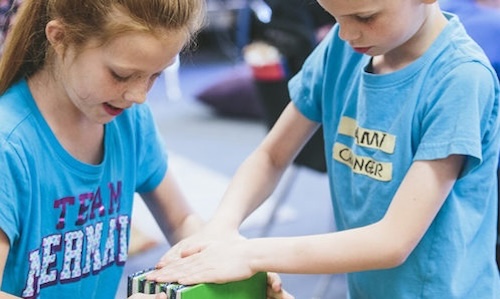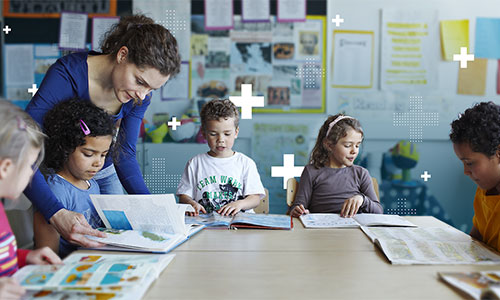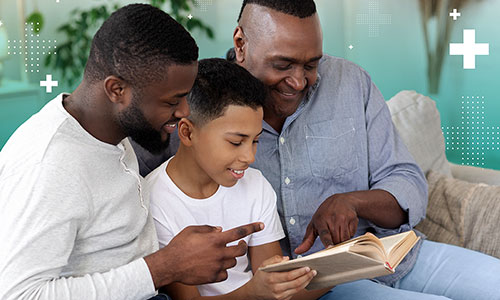
Children know a lot about language before they even learn to read. From the moment they are born, kids are exposed to all kinds of spoken language that helps them understand and make connections to written language years later. All that language—spoken to them, sung to them, read to them—becomes deposits in their language bank that they can use as they grow.
My daughter is a great example of how children bank language. She loved to have stories read to her before she learned to read. Her dad and I started reading to her not long after we brought her home from the hospital. After several years of picture books, we also began to read her our favorite chapter books, such as Winnie-the-Pooh and Charlotte’s Web, for as long as she would sit still and was interested. Sometimes we read just five or 10 minutes, but other times, during exciting parts, she would sit for an entire chapter.
I knew my daughter understood these longer stories because she would ask questions about the characters. It was clear she was taking the ideas we read to her and creating the stories in her mind. One day in particular, after something in her four-year-old life had not gone right for her, she came to me upset and said, “Will you comfort me?” I was so surprised to hear her ask for a hug that way, in such an unusual but completely appropriate way. It reminded me of a book we had been reading together. She had taken language she had heard and applied it to solve a problem she was experiencing. And of course, she got a hug!
My daughter was exhibiting language comprehension, something you may have heard your child’s teachers talk about. Although it may seem like a simple concept on the surface, I’d like to explore it and why it is important for reading more deeply. I’ll begin by defining the term and close with some tips on how you can support language comprehension at home.
What is language comprehension?
Language comprehension is the ability to understand the different elements of spoken or written language, like the meaning of words and how words are put together to form sentences. Language comprehension is one of the building blocks of reading comprehension.
Why is language comprehension important for reading?
Imagine that a child’s language bank is full of vocabulary, knowledge of how words make sentences, and information about the world. When the child begins to read, they will be better able to connect the words on the page to all these things.
Imagine the ability to read as a pyramid, as illustrated below. Reading comprehension, or being able to understand what you read, is the topmost block, and language comprehension is one of the blocks underneath it that supports reading comprehension. Decoding is the other block that supports reading comprehension. Together, reading comprehension, language comprehension, and decoding make up the Simple View of Reading.
The simple view of reading

Without language comprehension and decoding, reading comprehension is more difficult.
When do kids start developing language comprehension?
From birth to about age six, children are considered prereaders. They are learning sounds, letters, words, phrases, and what all those things mean. They begin to learn about books, too: how to hold one the right way and how to turn the pages. They go places with adults and experience new things. Even commonplace things, such as shopping or taking the bus, provide new experiences for children, especially if the adults talk with the children about what is going on. For example, talking about what you have to do to take the bus, the colors of the packages at the store, or how you pay for something provides new information for children to deposit in their language bank.
By listening, children also learn about grammar, or how to put words together correctly into sentences, and vocabulary. They then bring what they know about the world, including topics like science or history, and use that information to make connections and understand what they read.
What does language comprehension look like in action?
Let’s say that a child, Anna, has been learning English as a first or additional language. One day, when she is in first grade, her older sister reads these sentences to Anna, which are at a grade 3–5 level: “The sky lit up with color as the sun descended below the horizon. A soft breeze drifted through the trees as day turned to night. The four friends were ready to embark on a new adventure.”
Although these sentences might have been written for an older student to read independently, Anna can understand their meaning when her sister reads them to her. Anna knows about sunsets because she and her grandfather like to watch the sky change colors when the sun sets. That experience helps Anna understand that the first sentence is talking about a sunset, and she might guess that the word “descended” means that the sun is sinking below the skyline. In other words, Anna’s knowledge helps her make meaning of the story and of new vocabulary she hears. The more knowledge and vocabulary students like Anna gain through interacting with adults and the world around them, the stronger the building blocks they have for reading.
Listening to these sentences also helps Anna understand how sentences work. Each sentence has a subject (“sky,” “breeze,” “friends”) followed by an action (“lit up,” “drifted,” “were ready”). Even though young readers might not be able to independently read long or hard sentences, they are developing the building blocks they need to do that eventually by listening to others and matching those sentence structures when speaking themselves. Even toddlers pick up on this sentence structure when they say things like “No, I don’t want that.”
What can I do to support reading at home?
Here are three simple things you can do to support your child in developing language comprehension.
1. Interact with your child—about everything
Just as Anna’s grandfather helped her learn about sunsets, you are a great source of knowledge and language for your children. Find opportunities to interact with them and use language together every day. Read to them. Talk to them about what you do during the day or how your favorite sports teams are doing. Go for a walk around your neighborhood and talk about what you see. Take them on your errands and explain what you are doing and why.
You have so much experience to share, and kids have so much to learn about everything.
2. Help children find books they are interested in
Talk to your children, at any age, about what they are interested in and help them find books to read or be read to about those topics. Not sure where to start your book search? Try the Yale University Haskins Global Literacy Hub curated book list for suggestions on high-quality books you can look for at your local library. This website makes it easy to find books by age group. Read “7 websites with free audiobooks for kids (and where to start)” for information on getting free audiobooks.
3. Do language comprehension activities with your children
The following sites from Haskins can help you find activities to help your child with language comprehension: “Building vocabulary knowledge” and “Building background knowledge.” The Institute of Education Sciences also has a helpful handout titled “Talking and writing in the kitchen.”
Learn more
Just the fact that you are looking for ways to help your children improve their reading is important. Remember that helping your child improve their language comprehension is as easy as talking with them.
To learn more, download How to support reading at home: A guide for families and visit our archive of articles on supporting families.







